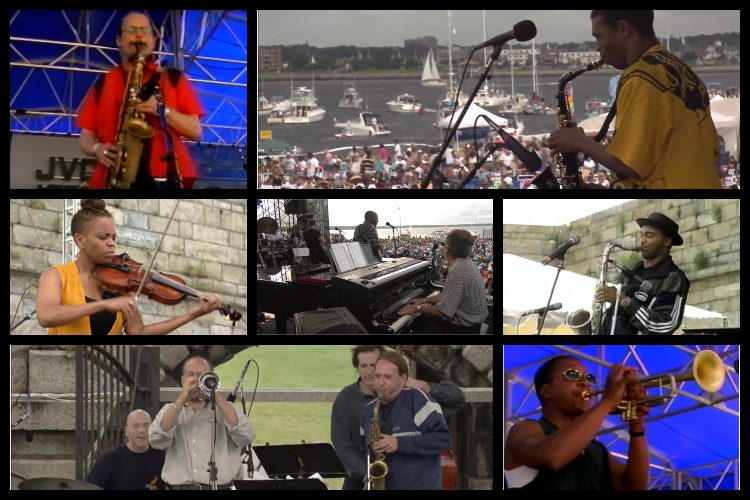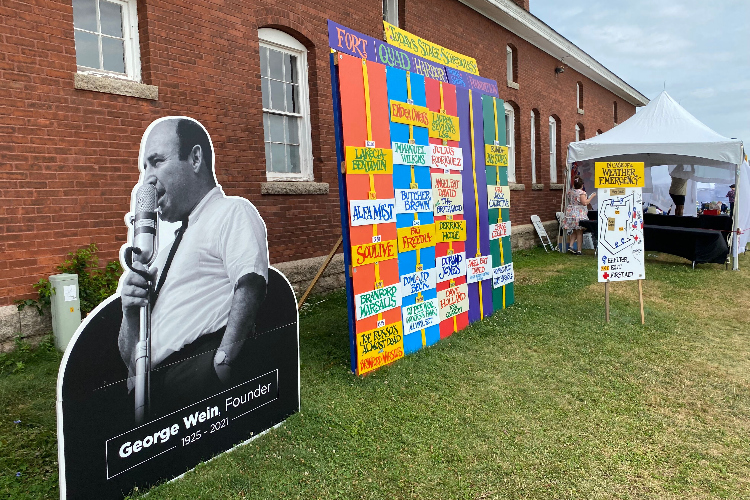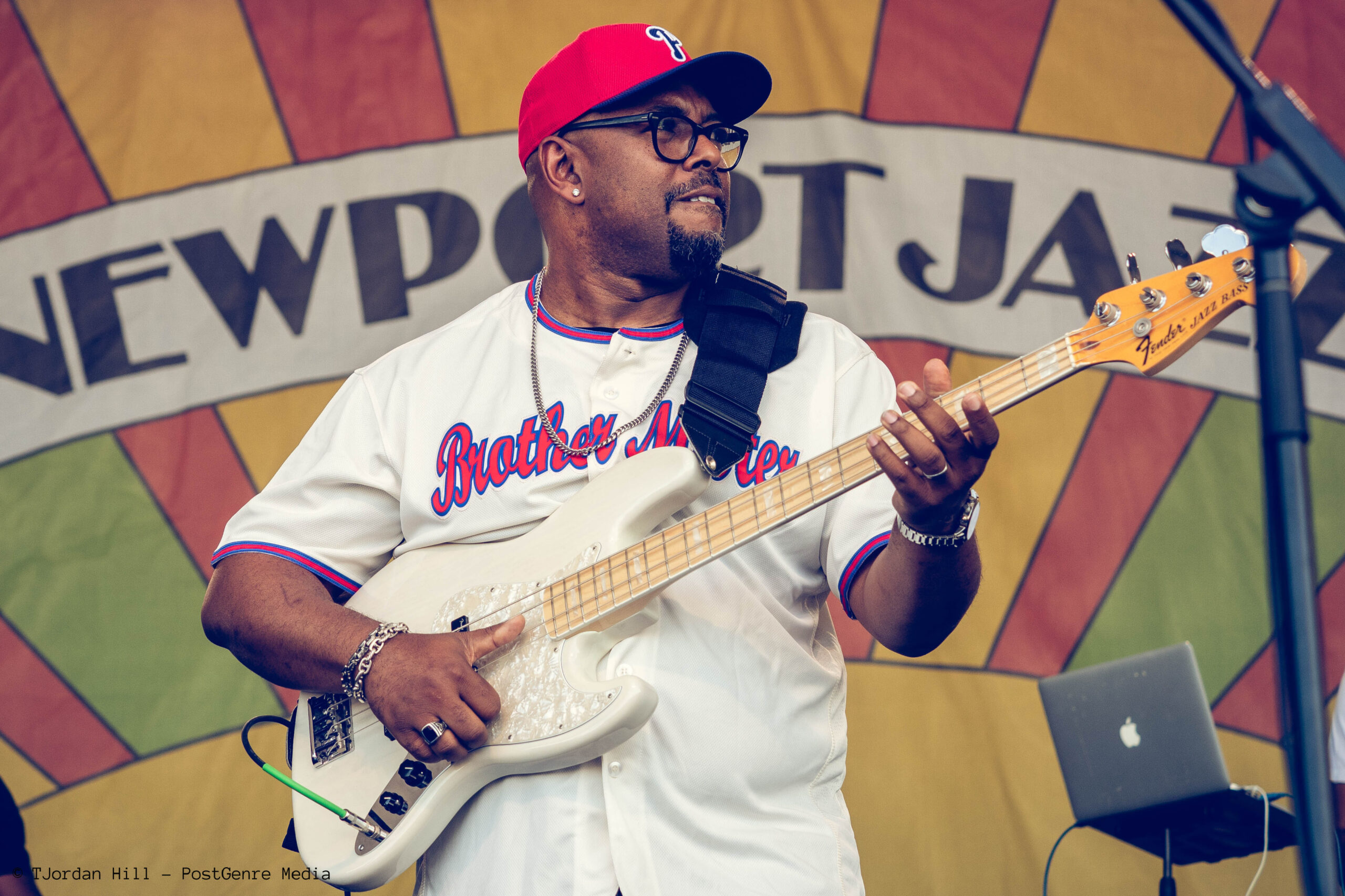A History of the Newport Jazz Festival – Chapter XII: Expansion, 1995-2003
|
Getting your Trinity Audio player ready...
|
In the four decades since the Newport Jazz festival first took place in 1954, it became a global brand with its production company- Festival Productions, Inc.- hosting hundreds of festivals worldwide. But only one other of their events took place in the city-by-the-sea; the Newport Folk Festival. This changed in 1995 with the birth of a third, the Newport Rhythm and Blues Festival. Formed as a collaboration with the Rhythm & Blues Foundation, the festival was a one-day affair intended to benefit musical pioneers who were mostly now struggling financially. Like its two older siblings, the festivities presented a top-caliber list of artists at Fort Adams. In the inaugural offering, they included Bonnie Raitt, Clarence Fountain and the Blind Boys of Alabama, Charles Brown, Ruth Brown, Pops Staples, Don Henley, Irma Thomas, and Sam Moore of Sam & Dave backed by a band led by Allen Toussaint and featuring Steve Cropper. There was also a surprise set by Billy Joel. The event attracted a sell-out crowd, indicating perhaps the birth of another successful festival.
While the Jazz Festival found a powerful partner in JVC and Folk had one with Ben & Jerry’s, the new Festival lacked any sponsor for its first year. It appeared that going into 1996, this shortcoming would be rectified as shoe manufacturer Rockport stepped up to provide financial support to the fledgling Rhythm and Blues Festival. For 1996, this led to a schedule that expanded to two days and boasted a lineup that featured Etta James, Boz Scaggs, Dr. John, Hank Ballard & the Midnighters, the Dixie Cups, Little Richard, Michael McDonald, Martha Reeves, Allen Toussaint’s Orchestra, Steve Cropper, and Duke Robillard. Chuck Berry – who last visited Newport in 1958 as captured on Jazz on a Summer’s Day – also performed.
The following year saw Patti LaBelle, Ben E. King, Delbert McClinton, Chuck Jackson, and others. There was also Aretha Franklin, the once twenty-year-old vocalist who impressed crowds at the 1962 Jazz Festival taking the stage at Fort Adams for the first time, now fully recognized as the Queen of Soul. But things were rocky for the new Rhythm and Blues Festival and, after Rockport pulled its sponsorship for financial reasons, the 1997 event proved to be its last. Ironically corporate sponsorship – a feature first originated by the Jazz Festival – would ultimately lead to the new festival’s demise. While the Rhythm and Blues Festival proved relatively short-lived, it was indicative of a larger trend for the Newport Festivals of that era: expansion.
Since returning home nearly a quarter-century earlier, the Jazz Festival remained primarily limited to a single stage alongside the fortress’s northern wall. The sole exception to this rule being the Friday night concerts at the Newport Casino. The 1995 Festival continued to follow these general logistics with Ray Charles at the Festival’s original home but the other performers-
Dorothy Donegan, Dianne Reeves, Gerry Mulligan’s Quartet, Roy Hargrove, Dr. John, and Rite of Strings with Al DiMeola, Stanley Clarke, and Jean Luc Ponty- all remained at the Fort’s singular stage. Earl Klugh, Grover Washington, Jr., and Larry Carlton with Lee Ritenour also performed, asserting that while “smooth jazz” had mostly disappeared from the spotlight, it still had followers. The Festival also celebrated its 40th Anniversary with an all-star band of Jon Faddis, Lew Tabackin, Warren Vache, Urbie Green, Ken Peplowski, Howard Alden, Mike LeDonne, Peter Washington, and Lewis Nash.
1995 also provided the sole Newport performance of saxophonist-flutist Thomas Chapin and his trio with bassist Mario Pavone and drummer Michael Sarin. Formerly Lionel Hampton’s bandleader in the 1980s, Chapin isn’t generally as well known as other artists of his generation, in part due to his death from Leukemia only three weeks after his 41st birthday. However, during his short life, Chapin excelled at providing a unique lyricism to his music that straddled sounds both “in” and “out.” His music is distinctly energetic and free-form yet accessible. While many in the audience may not have been familiar with his other works, possibly even his latest release, You Don’t Know Me (Arabesque, 1995), video from that summer confirms their excitement upon hearing him.
The 1996 Festival saw Mel Torme and Dave Brubeck at the Casino At the Fort, Chick Corea honored Bud Powell with a band that featured Wallace Roney, Joshua Redman, Christian McBride, and Roy Haynes. Michael Brecker joined as a special guest of McCoy Tyner’s Trio and Herbie Hancock’s Quartet. James Carter made his Newport debut with his Quartet augmented by Javon Jackson. Pianist Bruce Hornsby, known to most for his 1986 hit “The Way It Is,” performed in promotion of Hot House (RCA, 1995) which finds him alongside Pat Metheny and Bela Fleck in blurring the lines between rock, bluegrass, and jazz. Other artists included Ahmad Jamal, Al Jarreau, Manhattan Transfer, Spyro Gyra, and the Pat Martino Quartet with James Ridl, Steve Beskrone, and Scott Robinson
But by 1997, efforts were made to expand the Jazz Festival’s offerings. These came by way of an evening of Acid Jazz – a style that combines funk, soul, hip hop, jazz, and disco- by bands Liquid Soul and Brooklyn Funk Essentials. The venue was Newport’s historic Hotel Viking, a building built in 1926 and only a seven-minute walk down Bellevue Avenue from the Casino.
Also in 1997, the Tennis Hall of Fame and Casino saw a performance by Tito Puente and a tribute by Jon Faddis, Nicholas Payton, and Clark Terry to trumpet legend and Newport regular Dizzy Gillespie.
And, at the Fort, there were several returning artists including Ray Charles, Gato Barbieri, Dianne Reeves, Joe Zawinul and the Zawinul Syndicate, and George Benson. Herbie Hancock and Wayne Shorter performed in duet following the release of their 1 + 1 (Verve, 1997). Roy Hargrove explored Cuban music with his band Crisol for songs off of Habana (Verve, 1997) which would later earn him a Grammy Award for Best Latin Jazz Album. Fellow trumpeter Nicholas Payton appeared as a leader at Newport for the first time as did clarinetist Don Byron and vocalist Rachelle Farrell. In part as a nod to the growing jam band scene, Medeski, Martin and Wood – having recently recorded with John Scofield on A Go Go (Verve, 1998)- performed as well.
This growing interest in the jam band scene- musical emphasis on extended musical improvisation over rhythmic grooves and chord patterns, and long sets of music – would be represented in the summer of 1998 by the Festival as “Groove Night” at the Hotel Viking featuring the Greyboy Allstars and Galactic. It also signified a continued interest by Festival Productions to expand its musical offerings. Further, the interest in jam band music remained. 2001 and 2002 would also bring Karl Denson’s Tiny Universe to the Fort.
The 1998 Festival began with a sold-out performance of Al Jarreau and the T.S. Monk Band at the Casino. The two days at the Fort brought the reappearances of Aretha Franklin, David Sanborn, Dave Brubeck, Cassandra Wilson, and Michael Brecker. Arturo Sandoval – although at the 1978 Festival in New York – performed for the first time at Newport with his Hot House Big Band. Newport first-timers included “smooth” saxophonist Boney James, violinist Regina Carter, and singer-pianist Diana Krall.
The crowd’s response to Krall was so enthusiastic that she returned the following summer after the release of When I Look in Your Eyes (Verve, 1999), an album that among its many other honors would be the first jazz album nominated for the Grammy Award for Album of the Year in 25 years. Other vocalists to perform at the 1999 Festival included Kevin Mahogany and Harry Connick, Jr. Connick’s saxophonist Ned Goold also appeared with his own trio. Leroy Jones, a trumpeter who also collaborated with Connick and was originally part of Danny Barker’s Fairview Baptist Church Marching Band was joined by his quintet. Other artists included Joshua Redman, McCoy Tyner, Hank Jones’ trio featuring George Mraz and Dennis Mackrel, and “smooth” musicians Keiko Matsui and Will Downing with Gerald Albright.
That summer’s “Groove Night” would ultimately be the Festival’s final event at the Hotel Viking.* Instead, the stage set along Fort Adam’s northern wall would be renamed the “Fort Stage” and a second smaller one placed along the location’s eastern edge. Interestingly, this was not the first time Festival Production, Inc. had presented two stages at Fort Adams; in 1998 the company tested the format with The Gibson Guitar Festival featuring George Thorogood, Steve Morse, Charlie Hunter, Derek Trucks, and Bo Diddley, among othes. But the layout was a novelty for the Jazz Festival.Originally intended to present “smaller name” acts, the “Harbor Stage” would finally bring the efforts to expand the Festival closer to home.
The additional stage provided an opportunity for the Festival to effectively double its lineup and offer a wider range of musicians. This included bands that drew from music from around the world. To a large degree, this emphasis on different cultures was not new at the Festival. Consider, for instance, the meeting of Roy Ayers, Reggie Workman, Bruno Carr, Chick Ganimian, Gabor Szabo,Albert Mangelsdorf, and Babatunde Olatunji in 1967. But now more pre-existing groups could be invited to provide sounds from around the globe instead of solely one-off arrangements. Femi Kuti and his band, The Positive Force, displayed the connections between jazz and afrobeat. For ingenious composer-saxophonist John Zorn and his band, Masada, it was the style’s ties to klezmer. One of the most popular Latin singers of all time, Celia Cruz, also returned.
The Festival’s fascination with the intersection of jazz with rock and funk – which was explored in the 1969 festival in particular – was also further mined with Living Colour guitarist Vernon Reid, the band Deep Banana Blackout, and once James Brown saxman Maceo Parker. And, as always, the 2000 lineup was a mixture of new artists and more established favorites. As to the former, Vibraphonist Stefon Harris, with two Blue Note albums to his name (A Cloud of Red Dust (1998) and Black Action Figure (1999)) performed on the Harbor stage. So did saxophonist James Carter. Brian Blade and Kenny Garrett – both of whom performed with other bandleaders at the Festival in the past – presented their own bands.
Bob James, once the 25-year-old pianist who backed Sarah Vaughan during the 1964 Festival, presented his group Fourplay with Larry Carlton, Nathan East, and Harvey Mason. Other performers included Dianne Reeves, D.D. Jackson, Cassandra Wilson, the Carnegie Hall Jazz Band featuring Lew Tabackin, and “smooth” artists Boney James and Rick Braun. The opening concert at the Casino was the Bobby Short Orchestra and the Dave Brubeck Quartet.
Where the Rhythm and Blue Festival or the nights at the Hotel Viking faltered, the second stage addition proved very successful. For the 2001 Festival, the Harbor stage took on a sponsor and was redubbed the Mercedes Benz Pavillion. Despite the name change, the focus on emerging artists remained.
Jason Kibbler, better known as DJ Logic, became the first to bring a turntable to the Fort with his Project Logic (Ropeadope, 1999) band featuring Graham Haynes on trumpet and cornet. The international emphasis also returned. Los Hombres Calientes featuring Irvin Mayfield and Bill Summers found common ground between Latin music and New Orleans brass and David Sanchez’s Melaza Sextet jazz’s intersection with Puerto Rican folkloric rhythms. Simon Shaheen and Qantara added Middle Eastern sounds as well. Vocalist Nora York, New York-based band The Slip, and James Blood Ulmer led listeners through the space where jazz meets rock. And further underscoring the Festival’s focus on the next generation of musicians were two sons of artists who played a significant role in the event’s history and had established themselves as esteemed creators: Ravi Coltrane (John Coltrane) and Big Bill Morganfield (Muddy Waters).
The Fort Stage presented a series of artists who – other than Natalie Cole, Kurt Elling, and Jerry Gonzales and the Fort Apache Band – had appeared at the Festival at least once before: Krall, Brubeck, Hargrove, Ray Charles, and Chuck Mangione. Wayne Shorter – who had performed at Newport several times over the years from his own bands to playing saxophone in Miles Davis’ Second Great Quintet to a duet with Herbie Hancock – shared the first permanent acoustic group under his name; a quartet with Brian Blade, John Pattitucci, and Danilo Perez, which would remain together for almost two decades.
The summer of 2002 brought Tony Bennett to the Festival for the first time since his surprise appearance in 1966. He sang twice – first at the Casino then the next day as the closer at the Fort.
The Preservation Hall Jazz Band also made two appearances- once on each stage- on Saturday, August 11th.
The summer’s final performance was by Issac Hayes. Like Hayes, many other artists made their Newport debuts that summer including David S. Ware, Greg Osby’s Quartet featuring Jason Moran, and vocalists Oleta Adams and Lea DeLaria. Steven Bernstein’s Sex Mob provided several humorous avant-garde influenced covers of pop songs. The Antibalas Afrobeat Orchestra, Andres Levin’s Yerba Buena, and Jane Bunnett & Spirits of Havana fused musical ideas from around the world with jazz and- in some cases- other musical styles ranging from hip-hop to soul to funk to dub. The Holmes Brothers brought concepts from blues, soul, gospel, country, and rhythm & blues.
Following up on DJ Logic’s lead the prior summer, Kid Koala brought his turntable skills with the group Bullfrog. The ensemble Ballin’ The Jack showed the continued vitality of older sounds.
Returning performers ranged from Arturo Sandoval to Nicholas Payton’s Quintet with special guest James Carter to the ad hoc- now cringe-worthy due to its boss’s well-known moral and legal failings- unit called Cos of Good Music led by comedian Bill Cosby. There was also a supergroup of Herbie Hancock, Michael Brecker, and Roy Hargrove titled Directions in Music. The band examined the music of Miles Davis and John Coltrane and that same year, subbing out Willie Jones III and George Mraz for Brian Blade and John Pattitucci released an incredibly well received album recorded live at Massey Hall (Verve, 2002). Dave Holland also presented his quintet, with Robin Eubanks, Billy Kilson, Steve Nelson, and Chris Potter.
The 2003 Festival showcased the space where jazz meets pop with vocalists Peter Cincotti and K.D. Lang. The latter having recently recorded several tracks with Tony Bennett. Other singers throughout the weekend included India Arie, Lizz Wright, Me’Shell Ndegeocello, Cassandra Wilson, and the Boss Nova tinged Smokey & Miho. In addition to the revisitations of George Benson, Michel Camilo with David Sanchez, Stanley Clarke, Terence Blanchard, and Dave Brubeck there were many newcomers, some quite surprising.
Although Dewey Redman, Eddie Palmieri and Pat Metheny performed for the Festival in 1972, 1977, and 1979 respectively, it was the first time for all three – the last providing both solo and trio sets- in Newport proper. Saxophonist and soul-jazz icon Lou Donaldson also made his initial appearance well.
There were also a series of younger artists who were added to Newport’s historical legacy that summer. Soon after their release of These Are the Vistas (Columbia, 2003), the original incarnation of The Bad Plus- Ethan Iverson, Reid Anderson, and David King- showed that their artistic prowess went beyond just incredibly exciting and well-received versions of songs like Nirvana’s “Smells Like Teen Spirit.”
Vijay Iyer’s Quartet with Rudresh Mahanthappa, Stephan Crump, and Tyshawn Sorey provided not only compositions from their forthcoming Blood Sutra (Pi, 2003) but also a glimpse into the music’s future.
With the end of the summer of 2003, the Newport Jazz Festival edged ever closer to its most significant milestone to date: its 50th anniversary. From somewhat humble beginnings in a small club in Boston to near destruction by two riots, there were many reasons the Festival could have terminated years earlier. But, despite the odds, it continued to persevere and grow. Naturally, Festival Productions had a large celebration in mind to commemorate the moment. And, for an event that revolutionized music several times through the decades, that is quite a statement.
The 2021 Edition of the Newport Jazz Festival will take place from July 30th to August 1st at Fort Adams State Park. We plan to have live coverage of the event. More information can be found on the Festival’s website.
* However, one of the island’s best-kept secrets – the incredible low-power radio station, WXHQ- now broadcasts from the Hotel.



